Contents
Market Overview
Macro Introduction
Curve trends in U.S. Treasuries developing. Rates ended the week broadly unchanged after widening on Friday into the long weekend. The theme rests with a steeper 2s10s curve driven by 2yr outperformance following the $53bn drawdown in the TGA balance, while 10s30s flattened in spite of the 30yr touching 1.99%. Meanwhile the DBR-UST spread moved back above 160 bps but Bunds also edged wider on 5y5y inflation which has begun following the U.S. trajectory, while Eurozone political risk eased considerably (Italian 10yr vs German 10yr rates moved to 88 bps). U.S. equities also made fresh all-time highs and the VIX moved to 20.5 but news-flow was generally limited. Nevertheless, crude oil was up 2.2% on inventory data, with base metals outperforming given further hype around the next commodity “super-cycle”. As a high beta commodity play, ZAR assets outperformed ahead of Cyril Ramaphosa’s State of National Address and participation within interbank markets drove local rates to three-year lows. Elsewhere, a festival of inflation upside surprises in Central Europe hit screens, which validates the reflationary reflex in EM, which also benefits from larger CPI weights in food and energy over DM.
EM Credit Update
EM sovereign credit ended the week down 0.1% but corporate cedit was up 0.3%. Cameroon, Mongolia and Tunisia outperformed, while Sri Lanka, Ecuador and Belize lagged. We also note that EM sovereign HY outperformed US HY by 10 bps this week, which puts the spread differential at 172 bps as EM returns are starting to outperform. This comes as we saw the largest outflows in US HY in fifteen weeks, but the fifteenth largest inflow into EM debt ($3.1bn), where one would expect spread compression to remain a key theme going forward.
Week Ahead
Despite a shorter week with Presidents’ Day, Carnival and the Chinese New Year, the EM calendar is still reasonably heavy. We can expect GDP prints out of Colombia, Indonesia, Singapore and Thailand, along with rate decisions out of Indonesia (3.50%) and Turkey (17.0%). Beyond that, we will be keeping an eye on inflation data out of Israel where we look for signs of easing the deflationary path, and then out of South Africa with a higher figure driven by food and energy prices. Finally, economic and inflation data out of Brazil will be key to assess monetary normalization into the March MPC.
This week’s emerging markets highlights discussed below include the following: The first round of Ecuador’s Presidential elections; Biden and Xi’s first call; YPF’s exchange offer and consent solicitation; and Global emerging market corporates: Who’s afraid of the big rating agencies?
Fixed Income
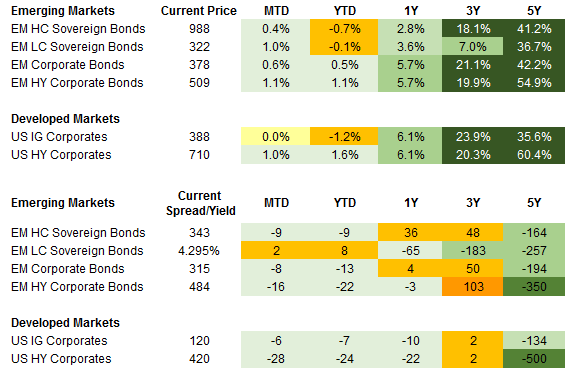
Equities
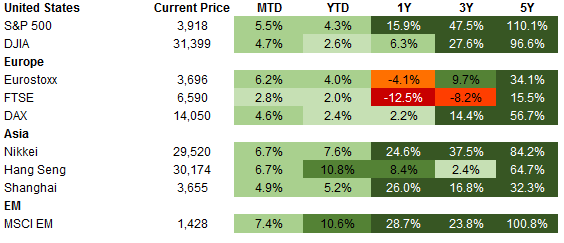
Commodities

Source for data tables: Bloomberg, JPMorgan, Gramercy. EM Fixed Income is represented by the following JPMorgan Indicies: EMBI Global, GBI-EM Global Diversified, CEMBI Broad Diversified and CEMBI Broad High Yield. DM Fixed Income is represented by the JPMorgan JULI Total Return Index and Domestic High Yield Index. Fixed Income, Equity and Commodity data is as of February 12, 2021 (Mid Afternoon).
Emerging Markets Weekly Highlights
The first round of Ecuador’s Presidential elections produces a rollercoaster experience for investors; populist candidate, Andres Arauz, is set to face market favorite, Guillermo Lasso, in the run-off on April 11
Event: The first round of Presidential elections in Ecuador took place last Sunday and offered a rarely seen political drama with four candidates managing to attract at least 15% of valid votes amid a field of sixteen contenders. Populist left-wing candidate and former President Rafael Correa’s proxy, 36-year-old Andres Arauz, emerged as the clear frontrunner with 32.6%. Until Wednesday afternoon, markets did not have confirmation on who will be joining him in the head-to-head runoff due to an extremely close race for second place. As of the time of writing, market-friendly right-wing candidate, Guillermo Lasso (19.7%), appears to have managed to overcome an initial deficit to edge out extreme-left indigenous candidate, Yaku Perez (19.5%), from the second round which is scheduled to take place on April 11. Meanwhile, fourth place moderate center-left candidate, Xavier Hervas (15.7%), majorly outperformed expectations and his support will be critically important in the second round contest. To add to an already challenging political picture, the elections also produced a highly fragmented National Assembly. Whomever wins the presidency in April will need to construct diverse and complex political alliances to implement policy.
Gramercy Commentary: Investors who follow Ecuador closely are used to dealing with elevated uncertainty and navigating a highly complex and dynamic political environment. However, this week’s elections produced extraordinary drama even for Ecuadorian standards, creating an unusually challenging economic and political outlook for markets to price. Amid all the uncertainty, one message from the election results resonated loud and clear. The current Moreno Administration’s focus on fiscal prudence and the severe economic and social stress due the pandemic have exerted a heavy toll on Ecuador’s society and the ensuing protest vote appears to be a rejection of fiscal austerity, favoring populist, anti-establishment and fringe candidates at the expense of traditional political figures such as Guillermo Lasso. In this context, the incoming Ecuadorian administration, regardless of its political ideology, will need to find a delicate balance between rolling back some austerity measures and supporting the economy’s recovery while maintaining a level of fiscal discipline consistent with the country’s dollarization regime and current IMF program. Dollarization, Ecuador’s most important and cherished institution and economic anchor, is a critical concept in navigating the current complex environment. We have conviction that any new administration that takes office in May has strong incentives to operate within the confines of dollarization and maintain cooperation with the IMF. Both are key pre-conditions for access to external financing flows, which are the lifeline of Ecuador’s dollarized economy and its important oil sector. As such, while an Arauz vs Lasso Presidential run-off scenario points to a rather binary outcome in terms of the general tone and modalities of economic policy going forward, we believe that even a populist Arauz Administration will maintain a level of pragmatism if elected. In addition to preserving the sacrosanct dollarization regime, logic dictates that Arauz and the Correista movement have little incentive to renege on external debt service over the term of the incoming administration, given the significant liquidity relief secured by Ecuador in last summer’s sovereign debt restructuring. Meanwhile, the elimination of Yaku Perez, a complete enigma for markets in terms of his economic policy agenda, from the second round of the Presidential race, arguably limits the downside for Ecuador’s Eurobonds. We expect that they will be trading in the coming two months on coalition building developments and Arauz/Lasso’s perceived chances to win. Upside risks relate to potential further moderation of frontrunner Arauz’s rhetoric on economic policy and/or markets assigning a higher probability of Lasso winning, and vice versa.
Biden and Xi’s first call points to a nuanced and competitive relationship
Event: On Wednesday, President Biden and President Xi Jinping held their first conversation since Biden’s inauguration and discussed a variety of issues including U.S. concerns regarding China’s unfair economic practices, human rights abuses in Xinjiang, growing restrictions in HK as well as increasingly assertive actions toward Taiwan. Biden expressed a desire for a ‘results-oriented’ relationship aligned with domestic and foreign allies’ interests.
Gramercy Commentary: The read-through of the conversation aligns with our expectation for a highly nuanced and complex U.S.-China relationship throughout 2021 and beyond, which will involve areas of cooperation and competition as well as confrontation. Tactics are likely to be more multilateral in nature and encompass offensive measures including public investment in R&D in areas such as technology, climate, and cybersecurity. Targeted defensive measures should persist particularly in the technology sector and related to human rights. We do not anticipate immediate action on tariffs albeit we see room for select and gradual removal later this year or early next year. This should have a moderately positive effect on Chinese growth albeit potentially offset by continuation of technology related measures over time.
YPF releases results of exchange offer and consent solicitation
Event: On Thursday morning, YPF announced the latest results of its exchange offer and consent solicitation. As of Wednesday, YPF had received 59.8% participation in the March 2021 Notes. This follows a public support of approval by the 2021 group after a last minute amendment to their economics. Participating 2021 bondholders will receive 41c in cash and 70c in new 26 Notes for every $1 of notional exchanged. While the 59.8% participation falls 20 bps short of the Central Bank’s mandated 60.0%, the announcement included a confirmation that YPF will have access to the FX market for the remaining 40.2%. In addition to the 21s, YPF announced participation results for the rest of its dollar curve. Results were as follows: 43% on the Apr-24s, 37% on the Mar-25s, 25% on the Jul-25s, 19% on the Jul-27s, 20% on the Jun-29s and 28% on the Dec-47s.
Gramercy Commentary: Based on our calculations, the company (and the country) should see ~$625m in dollar deferrals over the next two years. The amounts come predominantly from a smaller principal outflow on the Mar-21s (including the exchange cash consideration), interest savings over the next two years on the entire curve and savings on the 2021 and 2022 amortizations on the Apr-24s (30% in 2Q20) and Mar-25s (12.5% in each of 3Q21, 1Q22 and 3Q22). This exchange offer also provides immediate near-term relief to bondholders as it effectively resolves the existing ‘game of chicken’ between YPF and its bondholders. While the deferral of dollar outflows are relevant, they fall short of the ~$1.5bn in Capex shortfall for YPF, increase the company’s notional amount of debt by ~$120m and have created significant reputational noise over the last couple of weeks. Critically, YPF (and the C.B./MOF) will have to provide visibility on the next dollar amortizations. Besides the payment on the Mar-21s, the next amortizations are ~$42.5m payments on their Mar-25s in September 2021, March 2022 and September 2022 and, most importantly, a $260m amortization of the Apr-24s in April 2022.
Global emerging market corporates: Who’s afraid of the big rating agencies?
Event: Proving once again that rating agency actions still move markets, Fitch changed the outlook on Panama and corporates in the country, leading to weakness in the issuers’ bonds.
Gramercy Commentary: For emerging market corporates, sovereign rating actions can have repercussions even when the fundamentals of the corporate have not changed. This doesn’t only apply to corporates with government ownership. Sovereign rating ceilings are often applicable more broadly, capping ratings that can be assigned in a certain jurisdiction. Select issuers may however pierce the sovereign rating, due to foreign ownership or international diversification. Some recent rating changes have increased the focus on the divide between investment grade and high yield, given possible implications for investments. While benchmark indices and mandates are often still defined by this divide, over the last few months, some high yield issuers have raised funds at levels hitherto unheard of for issuers not rated Triple-B or higher. This suggests that downgrades may not be all bad. Although we are not experiencing the same voracity of rating cuts in emerging markets as just under a year ago, there are still downgrade risks in certain parts of our market. There are risks and opportunities in these rating changes. Downgrades can result in forced selling. Where valuations overshoot, there may be opportunities too.
Emerging Markets Technicals
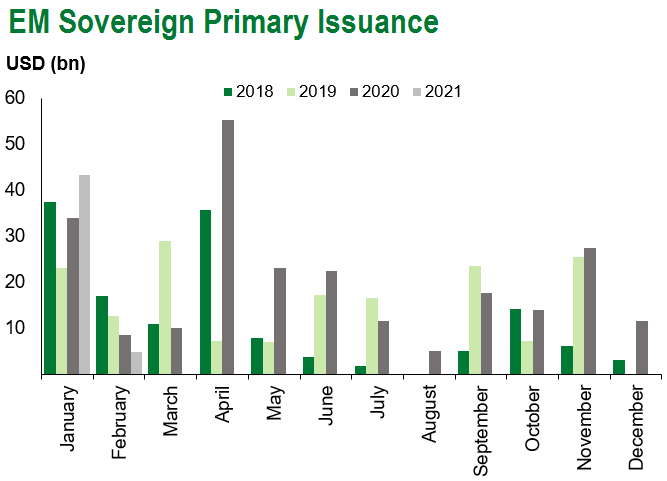
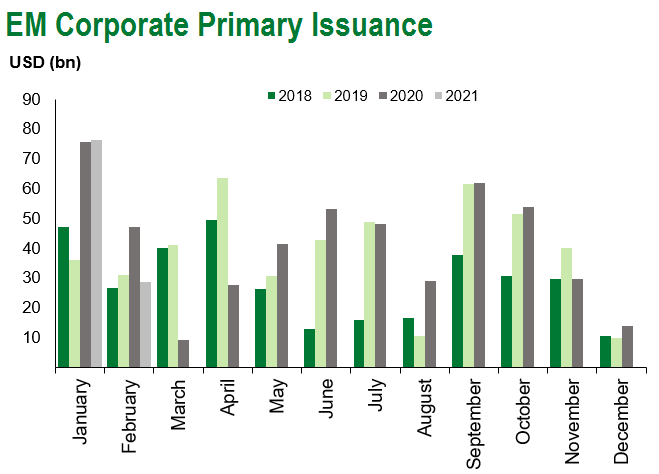
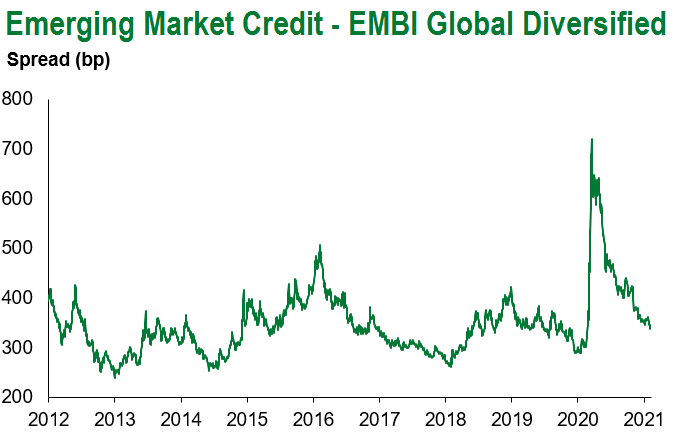
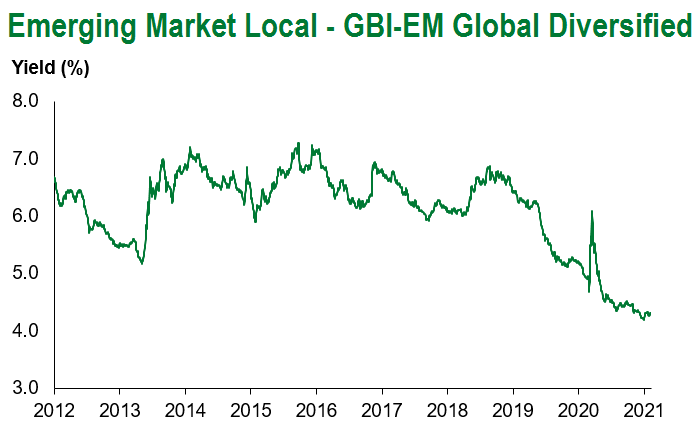
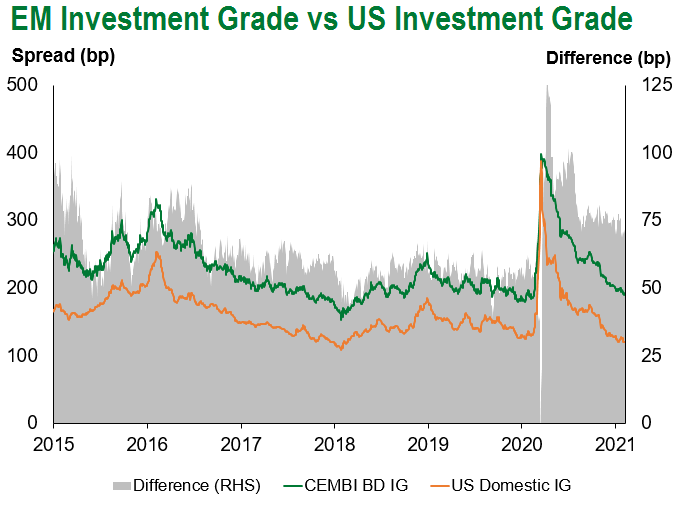
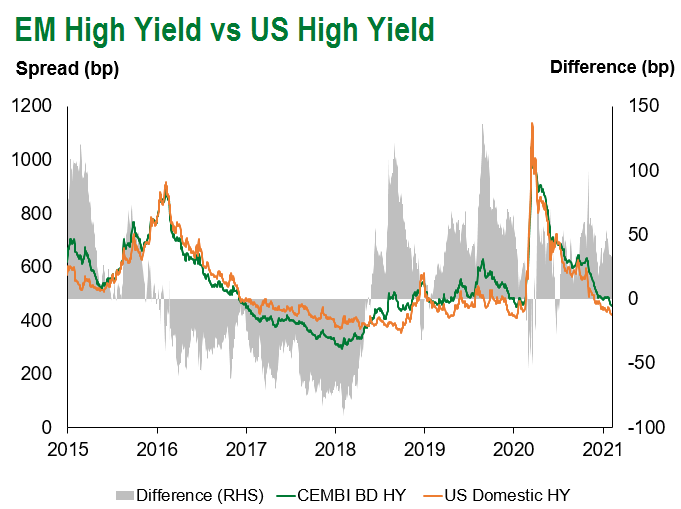
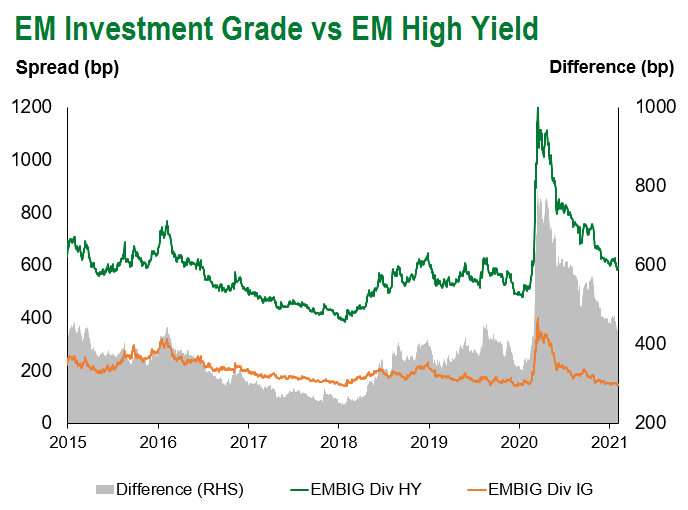
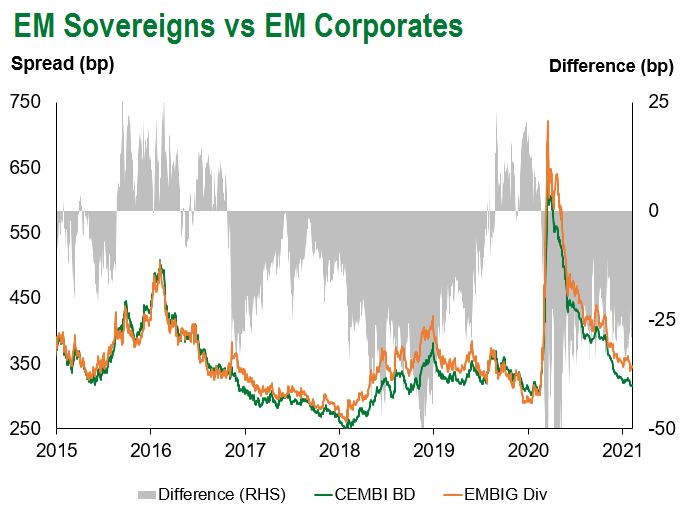
Emerging Markets Flows
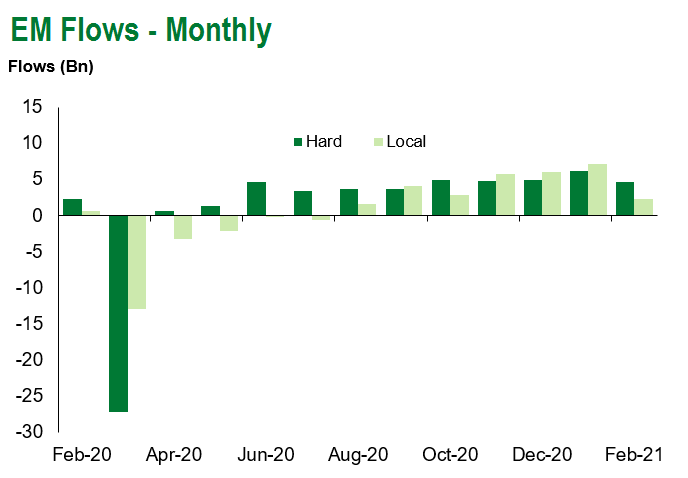
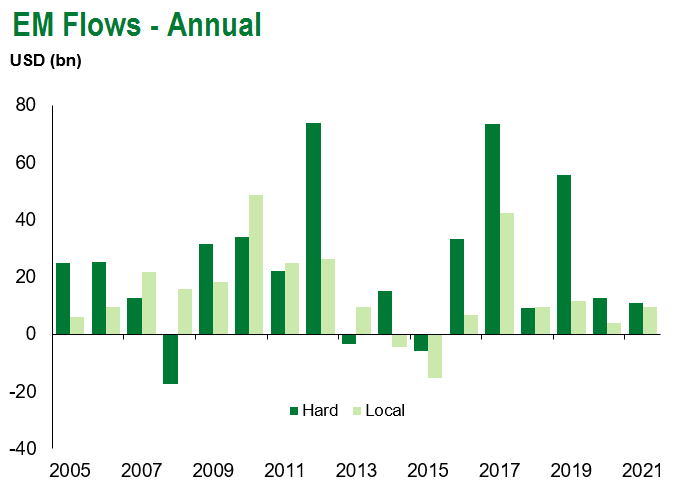
Source for graphs: Bloomberg, JPMorgan, Gramercy. As of February 12, 2021.
COVID Resources
Emerging Markets COVID-19 Case Summary
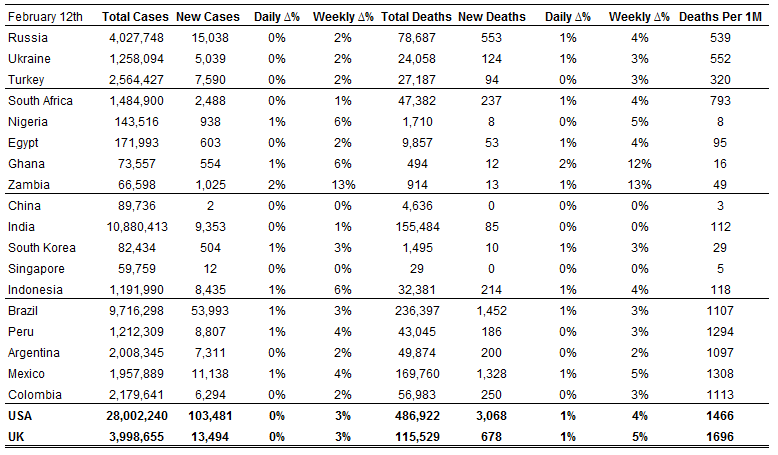
Source: Worldometer as of February 12, 2021.
Additional Crisis Resources:
Johns Hopkins COVID-19 Case Tracker
For questions, please contact:
Kathryn Exum, Senior Vice President, Sovereign Research Analyst, [email protected]
Petar Atanasov, Senior Vice President, Sovereign Research Analyst, [email protected]
Tolu Alamutu,CFA, Senior Vice President, Corporate Research Analyst, [email protected]
James Barry, Vice President, Corporate Research Analyst, [email protected]
This document is for informational purposes only. The information presented is not intended to be relied upon as a forecast, research or investment advice, and is not a recommendation, offer or solicitation to buy or sell any securities or to adopt any investment strategy. Gramercy may have current investment positions in the securities or sovereigns mentioned above. The information and opinions contained in this paper are as of the date of initial publication, derived from proprietary and nonproprietary sources deemed by Gramercy to be reliable, are not necessarily all-inclusive and are not guaranteed as to accuracy. This paper may contain “forward-looking” information that is not purely historical in nature. Such information may include, among other things, projections and forecasts. There is no guarantee that any forecasts made will come to pass. Reliance upon information in this paper is at the sole discretion of the reader. You should not rely on this presentation as the basis upon which to make an investment decision. Investment involves risk. There can be no assurance that investment objectives will be achieved. Investors must be prepared to bear the risk of a total loss of their investment. These risks are often heightened for investments in emerging/developing markets or smaller capital markets. International investing involves risks, including risks related to foreign currency, limited liquidity, less government regulation, and the possibility of substantial volatility due to adverse political, economic or other developments. The information provided herein is neither tax nor legal advice. Investors should speak to their tax professional for specific information regarding their tax situation.